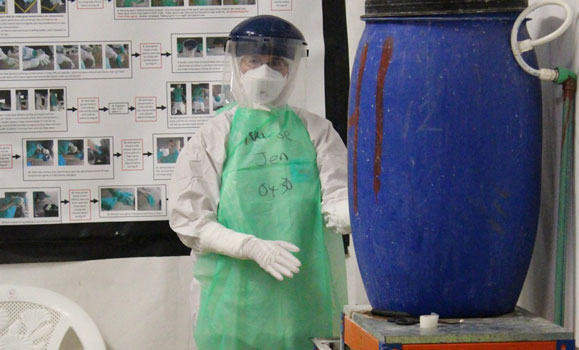The international response to the Ebola outbreak and how one Dal student has responded
Imagine waking up each morning knowing that you have a life threatening illness and that you likely won’t survive. Your only contact with the outside world is through a health provider, unrecognizable except for a name written on the front of her hazmat suit.
She doesn’t speak your language and you only speak a little English. You haven’t seen your family since you arrived at the field hospital and with the language barrier and the nurse’s face mask your conversations are stilted and you are afraid.
Now imagine that the faceless hazmat suit is approaching your bedside. Through hand signals and short sentences you slowly come to understand that you are disease-free and will be able to return to your family as a survivor of the most feared global disease of the decade.
Ebola has been all over the news this past year, with much of the discourse focusing on fear and uncertainty. Debates on how to intervene, and whether or not to close off Canadian borders to individuals coming from infected areas were prevalent both on our TV screens and in political debates.
Responding to the call for help
Although the international response has been criticized for delays, individuals from around the world took it on themselves to lend a helping hand. In the Dal School of Nursing, graduate student Jennifer Lawton took a semester off of school to go overseas to provide health care in the midst of the outbreak.
Lawton, who is in her last year of Dal’s Masters of Nursing program, has just finished a stint working at the Kerrytown Ebola Treatment Centre in Sierra Leone as a Canadian Armed Forces critical care nursing officer deployed on Operation Sirona.
“Operation Sirona is the military component of the Canadian government’s contribution to fighting the Ebola outbreak in West Africa,” explains Lawton. She worked at the Kerrytown Ebola Treatment Centre for 62 days, where Canadian Armed Forces personnel are working with UK military partners to treat local and international health care workers who have been exposed to the Ebola virus disease (EVD).
The challenges of working in an internationally run Ebola clinic have been eye opening for Lawton, particularly finding ways to interact with the patients.
“It has been a challenge to build a caring relationship with all of the PPE [Personal Protective Equipment] that we are wearing. All that patients can see are our eyes and the name we have written on our apron. Our voices are muffled speaking through the mask,” Lawton explains. It’s often not until patients are recovering that the health providers can really meet them for the first time.
“When patients are recovering and able to walk they often sit outside and we are able to say hi and introduce ourselves from the other side of the 2 [metre] gap.”
During her two months in Sierra Leone, Lawton saw firsthand the complexity of setting up and running a temporary, internationally-staffed hospital. “It is not providing nursing care that is difficult here, it is the logistics, it’s getting food, a supply system for our Personal Protective Equipment (PPE), and transport to and from work.”
When asked how her training at Dalhousie has helped prepare her for her current position, Lawton pointed to the non-clinical skills that have been a focus of her graduate work. “The critical thinking and leadership skills I have gained through the program helped me recognize problems and develop solutions to them. Working through the master’s program I have learned how important it is to understand other cultures and how cultural beliefs affect health. Understanding patient’s perceptions of the EVD helped me provide care in line with their culture.”
Analyzing the spread of the disease
Dr. Chris Simms, a professor in Dal’s School of Health Administration and a specialist on global diseases, says he first heard of Ebola in central Africa in 1994. So why has the disease spread so rapidly? And why now? According to Simms, “Nobody really knows why, yet” but there are several factors that facilitated the rapid spread of the disease.
“The collapse of the health care systems in several of the countries had a role to play,” says Simms. He also cites open and unregulated borders as a factor that prevented authorities from tracking individuals infected and those who have been exposed to the disease.
Fear of the disease, lack of local’s trust in Western interventions, and political motivations of people in international organizations also played a role in delaying aid. “The international community was slow to respond,” says Simms. “Much like the response to HIV several decades earlier.”
“The Ebola crisis should and could have been averted in early 2014, but got little attention until a couple of Americans became infected and were repatriated to the U.S for treatment,” says Dr. Janice Graham, a professor of pediatrics and social anthropology at Dalhousie. “It took five months for the World Health Organization (WHO) to declare a state of emergency.”
“In the meantime, the people in three heavily affected countries, Liberia, Sierra Leone and Guinea are among the poorest in the world, with only poor quality, pay-for-service health care.”
Delays by the international community weren’t the only problem, after a decision to intervene has been made, the receiving country is not always open to accepting intervention. Geopolitics and legacies of a traumatic colonial past can influence these decisions. “Poverty, lack of resources for even basic sanitation and health needs, and understandable fear after years of civil war and political unrest meant that assistance when it finally began to appear was not readily trusted,” says Graham.
This combination of international delays and national resistance and caution compounded the virulent spread of Ebola in some West African countries. But amidst these cautionary tales are also examples of areas where the spread of Ebola was squashed quickly and effectively.
In an article published on BMJ in November, Simms uses Senegal as an example of best practices in responding to critical disease outbreaks. Senegal has a good relationship with international organizations like the WHO, and responded immediately to the threat of an outbreak, quickly gaining control of Ebola within their borders. According to a recent report by the Economist, Senegal, which has been declared Ebola free, only reported 1 person infected—a stark contrast to Sierra Leone’s report of 11,301 people infected and 3,461 people dead.
Lessons learned
According to Simms, experts expect to see the Ebola outbreak end by June, however there are skeptics that question what is meant by an ‘end’.
As health care workers, health systems analysts and international health policy experts start to look at the spread and containment of Ebola, it’s clear that there are a lot of challenges with few easily implemented solutions.
“It isn’t as simple as getting on a plane and flying into the country to help,“ Lawton explains. “Everyone and every agency need to work together to both take care of patients and provide education and support for the local population.”
Deciding on a proper response to international health crises is an ongoing issue in development literature—one that hasn’t yet been solved. This can mean the immediate intervention of foreign health workers is a confusing and trying process for the volunteers, local health professionals and the patients and their families.
“It took several months of consultations and community engagement to work out the details of effective urgent response,” says Graham. “In the meantime, people died and community clinics carried out emergency procedures with no latrines, no anesthetics, no water, no medication.”
In crisis situations, decisions can be made and implemented so quickly that checks and balances aren’t built into the system. “Urgent response began by taking away and quarantining the sick in a communication vacuum, without ensuring access to essentials like food, or information to family members,” Graham explains.
Once a plan is in place, it is also important to make sure practitioners are providing culturally relative care. “It is important to work with interpreters to gain an understanding of the culture and be able to communicate in the same language. While most people here speak English, their English didn't often extend to health care related terminology. It was through the use of the interpreter that we were able to capture a full history of the EVD exposure,” Lawton explains.
Looking to the Future
Lawton believes Operation Sirona has been effective in Sierra Leone, “The number of new cases has decreased since our arrival in December,” she says, adding “both education about burial practices and providing care for the affected have helped.”
While Lawton’s work has impacted the people she treats, the experience has also affected her. “This has been the most rewarding nursing I have ever done. The days when a patient walks out of the facility cured of the EVD are overwhelming.”
Multiple factors led to culmination of the Ebola outbreak, including fear on all sides, political roles and motives, and a lack of trust in interventions. Looking to the future there are a lot of lessons to be learned from the shortcomings of the international response in 2014, lessons that will hopefully be internalized before another global disease strikes.
Recent News
- Transforming health scholarship: Dr. OmiSoore Dryden is leading a new era of Black Health Studies
- New aspiring Health Leaders Award invests in the future of health administration
- New clinic set to revolutionize respiratory care in Nova Scotia
- Grad profile: Inspired by the comfort and care of nurses
- Grad profile: Transformative network of support
- Grad profile: A career built on compassion and purpose
- Grad profile: Lifelong passion for serving others
- Grad profile: Leaving space for what comes next

